Explicit Multistep Mixed Finite Element Method for RLW Equation
Abstract
An explicit multistep mixed finite element method is proposed and discussed for regularized long wave (RLW) equation. The spatial direction is approximated by the mixed Galerkin method using mixed linear space finite elements, and the time direction is discretized by the explicit multistep method. The optimal error estimates in L2 and H1 norms for the scalar unknown u and its flux q = ux based on time explicit multistep method are derived. Some numerical results are given to verify our theoretical analysis and illustrate the efficiency of our method.
1. Introduction
In recent years, large nonlinear phenomena are found in many research fields, for example, physics, biology, fluid dynamics, and so forth. These phenomena can be described by the mathematical model of some nonlinear evolution equations. In particular, some attention has also been paid to nonlinear RLW equations [1, 2] which play a very important role in the study of nonlinear dispersive waves. Solitary waves are wave packet or pulses, which propagate in nonlinear dispersive media. Due to dynamical balance between the nonlinear and dispersive effects, these waves retain an unchanged waveform. A soliton is a very special type of solitary wave, which also keeps its waveform after collision with other solitons. The regularized long wave (RLW) equation is an alternative description of nonlinear dispersive waves to the more usual Korteweg-de Vries (KdV) equation. Mathematical theories and numerical methods for (1) were considered in [1–24]. The existence and uniqueness of the solution of RLW equation are discussed in [5]. Their analytical solutions were found under restricted initial and boundary conditions, and therefore they got interest from a numerical point of view. Several numerical methods for the solution of the RLW equation have been introduced in the literature. These include a variety of difference methods [5–8, 17], finite element methods based on Galerkin and collocation principles [9–13], mixed finite element methods [14–16], meshfree method [18], adomian decomposition method [19], and so on.
In [25], Chatzipantelidis studied the explicit multistep methods for some nonlinear partial differential equations and discussed some mathematical theories. Akrivis et al. [26] studied the multistep method for some nonlinear evolution equations. Mei and Chen [20] presented the explicit multistep method based on Galerkin method for regularized long wave (RLW) equation. In this paper, our purpose is to propose and study an explicit multistep mixed method, which combines a mixed Galerkin method in the spatial direction and the explicit multistep method in the time direction, for RLW equation. We derive optimal error estimates in L2 and H1 norms for the scalar unknown u and its flux q = ux for the fully discrete explicit multistep mixed scheme and compare our method’s accuracy with some other numerical schemes. Compared to the numerical methods in [20, 25, 26], we not only obtain the approximation solution for u, but also get the approximation solution for q = ux.
The layout of the paper is as follows. In Section 2, an explicit multistep mixed scheme and numerical process are given. The optimal error estimates in L2 and H1 norms for the scalar unknown u and its flux q = ux for the fully discrete explicit multistep mixed scheme are proved in Section 3. In Section 4, some numerical results are shown to confirm our theoretical analysis. Finally, some concluding remarks are given in Section 5. Throughout this paper, C will denote a generic positive constant which does not depend on the spatial mesh parameter h or time discretization parameter Δt.
2. The Mixed Numerical Scheme
Remark 1. There have been many numerical schemes for the RLW equation, but we have not seen the related research on explicit multistep mixed element method for RLW equation in the literature. From the viewpoint of numerical theory, we propose a mixed element scheme (6) and (7), which is different from some other mixed finite element methods in [14–16], for the RLW equation and derive some a priori error estimates based on the explicit multistep mixed element method. From the perspective of numerical calculation, our method is efficient for RLW equation.
3. Two-Step Mixed Scheme and Optimal Error Estimates
3.1. Two-Step Mixed Scheme and Some Lemmas
In this section, we will discuss some a priori error estimates based on explicit 2-step mixed finite element method for the RLW equation. For the fully discrete procedure, let 0 = t0 < t1 < ⋯<tN = T be a given partition of the time interval [0, T] with step length Δt = T/N, for some positive integer N. For a smooth function ϕ on [0, T], define ϕn = ϕ(tn).
For the theoretical analysis of a priori error estimates, we define the following projections.
Lemma 2 (see [15], [27], [28].)One defines the elliptic projection by
Lemma 3 (see [15], [27], [28].)Furthermore, one also defines a Ritz projection of q as the solution of
With , the following estimates hold:
Lemma 4. For τn+1, , , and , the following estimates hold:
Proof. Using the Taylor expansion, we have
From (41), we have
3.2. Optimal Error Estimates
In this subsection, we derive the fully discrete optimal error estimates and obtain the following theorem.
Theorem 5. Assuming that U0, U1 ∈ Vh and Z0, Z1 ∈ Wh are given, then for 1 ≤ J ≤ M, j = 0,1, one has
Proof. Taking vh = ςn+1 in (33) and using Cauchy-Schwarz’s inequality and Poincaré’s inequality, we get
Remark 6. Compared to a variety of difference methods in [17], our method is studied based on mixed element scheme (6) and (7).
Remark 7. Although some convergence proofs of multistep methods for RLW/BBM are provided in [20, 25, 29], our convergence results of multistep methods are proved based on a mixed finite element scheme. Based on the current discussion, we have to provide the detailed proofs for multistep mixed finite element methods in this paper.
4. Numerical Results
In this procedure, we take space-time domain as −40 ≤ x ≤ 60 and 0 ≤ t ≤ 20.
In Table 1, we take spatial mesh parameter h = 0.125 and time discretization parameter Δt = 0.1 and list the three invariants Q1, Q2, and Q3 and the optimal error estimate in L2 and L∞ norms for u at different times t = 0, 4, 8, 12, 16, and 20. At the same time, we show some numerical results at time t = 20 obtained by other numerical methods in Table 1. From Table 1, we find that our method is more accurate than the numerical methods in [17, 18, 28] but is less than the numerical methods in [23, 24]. From the shown results in Table 1, we can see that Q1, Q2 and Q3 keep almost constants, so the conservation for our method is very well.
| Method | Time | Q1 | Q2 | Q3 | L2 for u | L∞ for u |
|---|---|---|---|---|---|---|
| Our method | 0 | 3.9797 | 0.8104 | 2.5787 | 0 | 0 |
| 4 | 3.9797 | 0.8104 | 2.5786 | 3.6304e − 004 | 5.2892e − 005 | |
| 8 | 3.9797 | 0.8104 | 2.5786 | 7.2873e − 004 | 5.8664e − 005 | |
| 12 | 3.9797 | 0.8104 | 2.5787 | 1.0817e − 003 | 6.3283e − 005 | |
| 16 | 3.9795 | 0.8104 | 2.5787 | 1.4186e − 003 | 6.8001e − 005 | |
| 20 | 3.9790 | 0.8103 | 2.5785 | 1.7396e − 003 | 7.7154e − 005 | |
| [20] | 20 | 3.9800 | 0.8104 | 2.5792 | 1.7569e − 003 | 6.8432e − 004 |
| [21] | 20 | 3.9820 | 0.8087 | 2.5730 | 4.688e − 003 | 1.755e − 003 |
| [22] | 20 | 3.9905 | 0.8235 | 2.6740 | 2.157e − 003 | — |
| [23] | 20 | 3.9616 | 0.8042 | 2.5583 | 0.018e − 003 | 1.566e − 003 |
| [24] | 20 | 3.9821 | 0.8112 | 2.5813 | 0.511e − 003 | 0.198e − 003 |
In Tables 2 and 3, we take spatial mesh parameter h = 0.125 and obtain the optimal error results in L2 and L∞ norms for u at different times t = 0, 4, 8, 12, 16, and 20 with different time discretization parameters Δt = 0.1,0.2, and 0.4. From Tables 2 and 3, we see easily that the convergence rate for time is close to order 2. Similarly, the results for q are shown in Tables 4 and 5.
| Time | Δt = 0.4 | Δt = 0.2 | Δt = 0.1 | Order (0.2/0.4) | Order (0.1/0.2) |
|---|---|---|---|---|---|
| 4 | 5.3805e − 003 | 1.4267e − 003 | 3.6304e − 004 | 1.9151 | 1.9745 |
| 8 | 1.1688e − 002 | 2.9411e − 003 | 7.2873e − 004 | 1.9906 | 2.0129 |
| 12 | 1.7830e − 002 | 4.3997e − 003 | 1.0817e − 003 | 2.0188 | 2.0241 |
| 16 | 2.3751e − 002 | 5.7916e − 003 | 1.4186e − 003 | 2.0360 | 2.0295 |
| 20 | 2.9434e − 002 | 7.1148e − 003 | 1.7396e − 003 | 2.0486 | 2.0321 |
| Time | Δt = 0.4 | Δt = 0.2 | Δt = 0.1 | Order (0.2/0.4) | Order (0.1/0.2) |
|---|---|---|---|---|---|
| 4 | 8.0743e − 004 | 2.0299e − 004 | 5.2892e − 005 | 1.9919 | 1.9403 |
| 8 | 9.1778e − 004 | 2.2908e − 004 | 5.8664e − 005 | 2.0023 | 1.9653 |
| 12 | 9.9866e − 004 | 2.4966e − 004 | 6.3283e − 005 | 2.0000 | 1.9801 |
| 16 | 1.0718e − 003 | 2.6685e − 004 | 6.8001e − 005 | 2.0059 | 1.9724 |
| 20 | 1.1277e − 003 | 2.8609e − 004 | 7.7154e − 005 | 1.9788 | 1.8907 |
| Time | Δt = 0.4 | Δt = 0.2 | Δt = 0.1 | Order (0.2/0.4) | Order (0.1/0.2) |
|---|---|---|---|---|---|
| 4 | 2.4430e − 003 | 6.4427e − 004 | 1.6260e − 004 | 1.9229 | 1.9863 |
| 8 | 5.1823e − 003 | 1.2934e − 003 | 3.1976e − 004 | 2.0024 | 2.0161 |
| 12 | 7.6616e − 003 | 1.8713e − 003 | 4.5963e − 004 | 2.0336 | 2.0255 |
| 16 | 9.8719e − 003 | 2.3787e − 003 | 5.8232e − 004 | 2.0532 | 2.0303 |
| 20 | 1.1843e − 002 | 2.8251e − 003 | 6.8991e − 004 | 2.0677 | 2.0338 |
| Time | Δt = 0.4 | Δt = 0.2 | Δt = 0.1 | Order (0.2/0.4) | Order (0.1/0.2) |
|---|---|---|---|---|---|
| 4 | 1.1595e − 004 | 2.7265e − 005 | 6.3127e − 006 | 2.0884 | 2.1107 |
| 8 | 1.9712e − 004 | 4.6625e − 005 | 1.0725e − 005 | 2.0799 | 2.1201 |
| 12 | 2.5295e − 004 | 5.9837e − 005 | 1.3579e − 005 | 2.0797 | 2.1397 |
| 16 | 2.9012e − 004 | 6.8641e − 005 | 1.5594e − 005 | 2.0795 | 2.1381 |
| 20 | 3.1768e − 004 | 7.5864e − 005 | 1.7195e − 005 | 2.0661 | 2.1414 |
In Tables 6 and 7, the optimal error results in L2 and L∞ norms for u at different times t = 0, 4, 8, 12, 16, and 20 with different spatial mesh parameters h = 0.2, 0.4, and 0.8 and time discretization parameter Δt = 0.01 are shown. It is easy to see that the convergence rate for space is close to order 2. The similar results for q are listed in Tables 8 and 9.
| Time | h = 0.8 | h = 0.4 | h = 0.2 | Order (0.4/0.8) | Order (0.2/0.4) |
|---|---|---|---|---|---|
| 4 | 1.7109e − 003 | 4.2677e − 004 | 1.1449e − 004 | 1.9940 | 1.8982 |
| 8 | 1.8945e − 003 | 4.6862e − 004 | 1.1924e − 004 | 2.0195 | 1.9746 |
| 12 | 2.1232e − 003 | 5.2130e − 004 | 1.3025e − 004 | 2.0102 | 2.0008 |
| 16 | 2.3559e − 003 | 5.7598e − 004 | 1.4421e − 004 | 2.0589 | 1.9978 |
| 20 | 2.5778e − 003 | 6.3407e − 004 | 1.7877e − 004 | 2.0358 | 1.8265 |
| Time | h = 0.8 | h = 0.4 | h = 0.2 | Order (0.4/0.8) | Order (0.2/0.4) |
|---|---|---|---|---|---|
| 4 | 2.1763e − 003 | 5.8447e − 004 | 1.5502e − 004 | 1.8967 | 1.9147 |
| 8 | 4.7892e − 003 | 1.2098e − 003 | 3.0533e − 004 | 1.9850 | 1.9863 |
| 12 | 7.2371e − 003 | 1.7871e − 003 | 4.4434e − 004 | 2.0178 | 2.0079 |
| 16 | 9.4746e − 003 | 2.3084e − 003 | 5.7081e − 004 | 2.0372 | 2.0158 |
| 20 | 1.1534e − 002 | 2.7859e − 003 | 6.8980e − 004 | 2.0497 | 2.0139 |
| Time | h = 0.8 | h = 0.4 | h = 0.2 | Order (0.4/0.8) | Order (0.2/0.4) |
|---|---|---|---|---|---|
| 4 | 2.3426e − 004 | 5.4759e − 005 | 1.2581e − 005 | 2.0969 | 2.1218 |
| 8 | 4.2831e − 004 | 1.0038e − 004 | 2.2853e − 005 | 2.0932 | 2.1350 |
| 12 | 5.7270e − 004 | 1.3452e − 004 | 3.0443e − 005 | 2.0900 | 2.1436 |
| 16 | 6.7812e − 004 | 1.5951e − 004 | 3.5927e − 005 | 2.0879 | 2.1505 |
| 20 | 7.5693e − 004 | 1.7832e − 004 | 4.0176e − 005 | 2.0857 | 2.1501 |
| Time | h = 0.8 | h = 0.4 | h = 0.2 | Order (0.4/0.8) | Order (0.2/0.4) |
|---|---|---|---|---|---|
| 4 | 1.1957e − 003 | 3.1367e − 004 | 7.8812e − 005 | 1.9305 | 1.9928 |
| 8 | 2.4344e − 003 | 6.0206e − 004 | 1.4825e − 004 | 2.0156 | 2.0219 |
| 12 | 3.4768e − 003 | 8.3962e − 004 | 2.0540e − 004 | 2.0500 | 2.0313 |
| 16 | 4.3743e − 003 | 1.0402e − 003 | 2.5371e − 004 | 2.0722 | 2.0356 |
| 20 | 5.1677e − 003 | 1.2153e − 003 | 2.9544e − 004 | 2.0882 | 2.0404 |
Figure 1 shows the surface for the exact solution u in space-time domain ((x, t)∈[−20,60]×[0,20]), and the corresponding surface for the numerical solution uh with h = 2 and Δt = 0.4 is described in Figure 2. From Figures 1 and 2, we see easily that the exact solution u is approximated very well by the numerical solution uh. In Figures 3 and 4, we show the surface for the exact solution q and the numerical solution qh, respectively, with h = 2 and Δt = 0.4 and obtain a good approximation solution qh for the exact solution q.
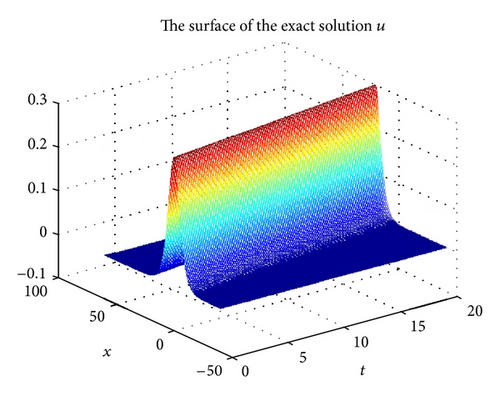
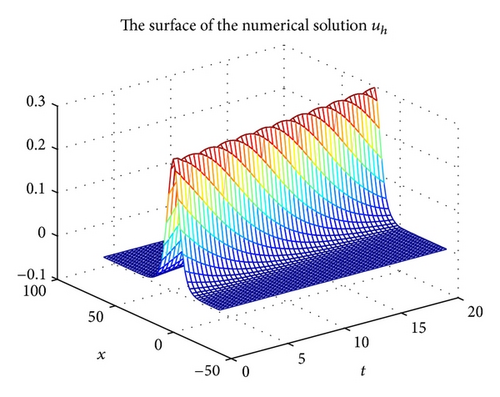
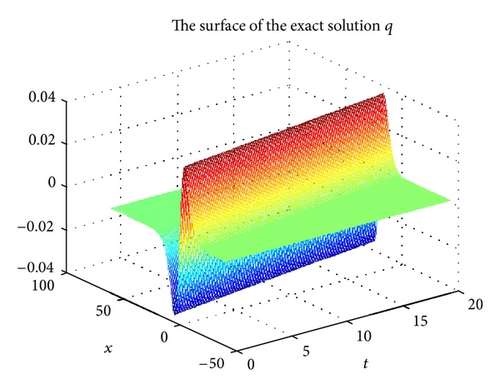
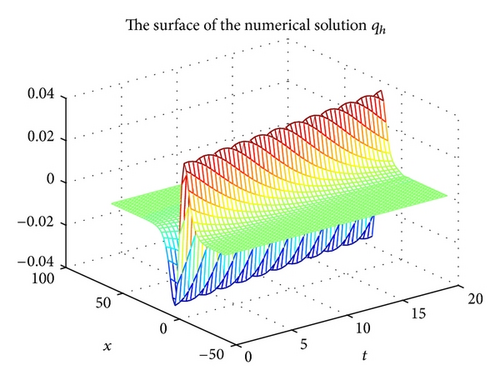
The comparison between the exact solution u and the numerical solution uh is described at different times t = 4,8, 12,16, and 20 with h = 0.125 and Δt = 0.2 in Figure 5. The similar comparison for the exact solution q and the numerical solution qh is shown in Figure 6. Figures 5 and 6 show that the solitary wave for u and q moves to the right with unchanged form and velocity, respectively. Furthermore, the exact solutions u and q are approximated well by the numerical solutions uh and qh, respectively.
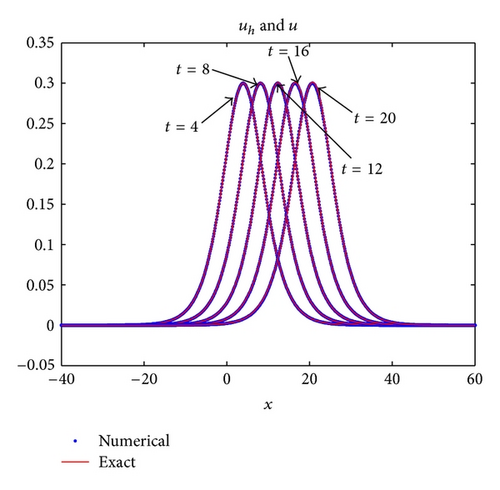
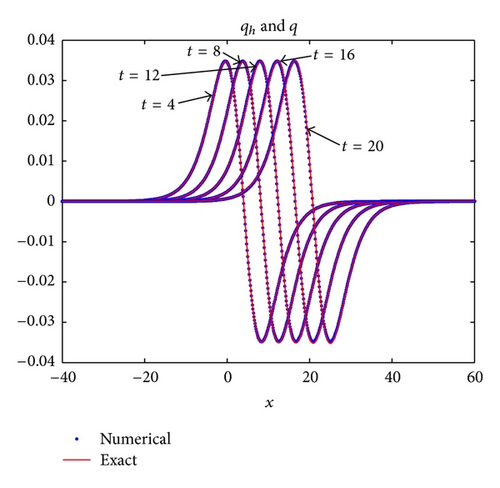
In Figure 7, we show the comparison between u and uh at different spaces x = 0,10,20, and 30 with h = 0.125 and Δt = 0.2 to verify the efficiency for the proposed scheme in this paper. Figure 8 describes a similar result for q.
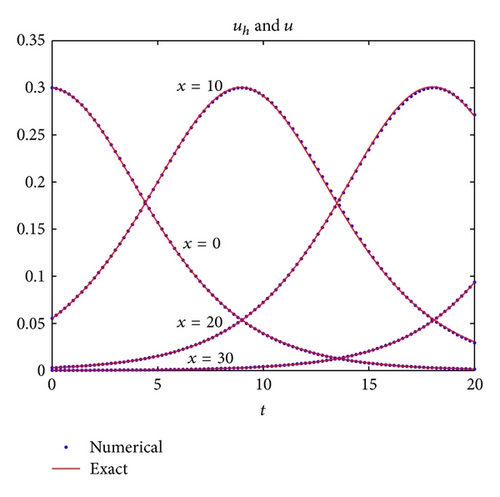

From the previous analysis in Tables 1–9 and Figures 1–8, we can see that the numerical results confirm the theoretical results of Theorem 5 and our method is efficient for RLW equation.
5. Concluding Remarks
In this paper, we propose and analyze an explicit multistep mixed finite element method, which combines spatial mixed finite element method and time explicit multistep method, for RLW equation. We discuss the numerical process for our method, prove the theoretical results for the fully discrete explicit multistep mixed scheme, obtain the optimal convergence order, and compare our method’s accuracy with some other numerical schemes. Compared with the numerical method in [20, 25, 26], our method can obtain the optimal error estimates in L2 and H1 norms for the scalar unknown u and its flux q = ux simultaneously. From our numerical results, we can see that our method is efficient for RLW equation.
Acknowledgments
This work was supported by the National Natural Science Fund of China (11061021), the Scientific Research Projection of Higher Schools of Inner Mongolia (NJZZ12011 and NJZY13199), the Natural Science Fund of Inner Mongolia Province (2012MS0108 and 2012MS0106), and the Program of Higher-Level Talents of Inner Mongolia University (125119).




